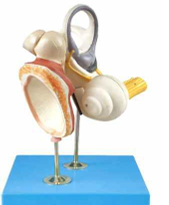رَبِّ زِدْنِي عِلْماً

Inner Ear, Auditory ssicle and Tympanic Membrane
Nursing Modals
₹82.00₹22.00
The inner ear plays a crucial role in our ability to hear and maintain balance. It is composed of several intricate structures, including the auditory ossicles, which are three small bones known as the malleus, incus, and stapes. These ossicles amplify sound waves that enter through the tympanic membrane, commonly known as the eardrum. When sound waves hit the tympanic membrane, it vibrates, transferring these vibrations to the ossicles. The ossicles then transmit the amplified sound to the cochlea in the inner ear, where sensory cells convert the mechanical vibrations into electrical signals. These signals are then sent to the brain, allowing us to perceive sound. The delicate interplay between the tympanic membrane and the auditory ossicles is essential for clear hearing and demonstrates the complexity of the auditory system.
Features:
1. Consists of three parts: inner ear, a u d i t o r y o s s i c l e a n d t y m p a n i c membrane Height 18cm Width 17cm Thickness 19 cm Enlarged approx-4 times big
Training
Providing essential healthcare training and simulation solutions.
COntacts
Support
info@medisureinternational.com
+91 9972123423
© Medisure. All Rights Are Reserved
Crafted with ❤️by Influence Kashmir
